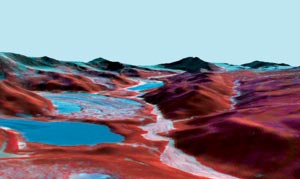Glacial Lake Outburst Floods
Glacial lake outburst floods (GLOF) are a common hazard to the high mountains of Bhutan, China, India, Nepal, and Pakistan. Glacial  lakes that pose this type of danger are formed by the retreat of the glacier; water from the ice melt is retained by the glacier's terminal moraine. Eventually, either the volume of water becomes too great for the moraine to support or an event such as a large ice block detachment occurs and the moraine is breached. The resulting flood can cause devastating damage to property and infrastructure and frequently results in loss of life.
lakes that pose this type of danger are formed by the retreat of the glacier; water from the ice melt is retained by the glacier's terminal moraine. Eventually, either the volume of water becomes too great for the moraine to support or an event such as a large ice block detachment occurs and the moraine is breached. The resulting flood can cause devastating damage to property and infrastructure and frequently results in loss of life.
Above right: A three-dimensional perspective of Lugge glacial lake in Bhutan showing the effects of the Lugge Tsho GLOF. 1999 IRS ID LISS3 and PAN data.
A GLOF in China in 1964 destroyed many kilometers of highway and washed 12 timber trucks 71 km from the scene. More recently, a GLOF from Dig Tsho in Nepal in 1985 destroyed a microhydropower station and 14 bridges, and as a result, many people died. By constructing an inventory of glaciers and glacial lakes, it is possible to establish which lakes form a threat. Such inventories have been made for Bhutan and Nepal.
For Nepal, spatial and attribute data sets from topographic maps and aerial photographs were gathered to create a digital database of glaciers and glacial lakes. Satellite images were processed using ERDAS IMAGINE. All data was integrated and imported into ArcView. The inventory revealed that there are 3,252 glaciers and 2,315 glacial lakes in Nepal. Of these, only 20 glacial lakes are considered to have a high potential for GLOF events.
At present, the Tsho Rolpa glacial lake has an early warning system and mitigation measures. A GLOF event from this lake could have damaging effects up to 100 km downstream, threatening more than 10,000 people and much infrastructure including a hydropower plant. The early warning system consists of sensors that relay a signal downstream and to Radio Nepal in the event of a GLOF. People are warned either by siren or emergency radio messages broadcast from Kathmandu. Mitigation measures consist of the construction of a canal with a gate on the top of the moraine. During the first phase, this construction has allowed the water level of the lake to be lowered by 3 m. In subsequent phases, the water level will be lowered by 20 m more.
For more information, contact Pradeep Mool (pradeep@icimod.org.np) or visit ICIMOD's Web site at www.icimod.org.
